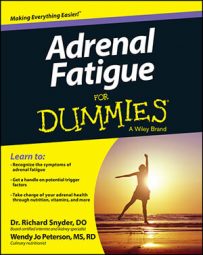Before delving into adrenal fatigue, you should have a working knowledge of the structure and function of the adrenal glands. Understanding where they are and how they interact with other organs of the body is important in helping yourself, because the more you know, the better advocate you can be for your own health.
The two adrenal glands are shaped like little triangles, and they sit atop the kidneys in much the same way a hat sits atop someone's head. Using the spine as a reference, they're under your ribs where your mid back area (the thoracic spine) meets your lower back (the lumbar spine).
Because the adrenal glands and the kidneys are so attached to one another, health conditions that affect the adrenal glands can affect the kidneys as well. In Chinese medicine, the kidneys and adrenal glands are actually thought of as being one organ system.
![[Credit: Illustration by Kathryn Born, MA]](https://www.dummies.com/wp-content/uploads/420454.image0.jpg)
Each adrenal gland has an outer part and an inner part, all enclosed by a capsule. Here's what each part does:
Adrenal capsule: This capsule of connective tissue encases the adrenal gland, serving as a protective layer. It's primarily composed of adipose tissue (fat).
Adrenal cortex: This outer part of the adrenal gland comprises more than 75 percent of the adrenal gland. It has three zones, each of which performs a distinct function:
The zona glomerulosa makes the blood-pressure regulating hormone aldosterone.
The zona fasciculata makes cortisol.
The zona reticularis makes sex hormones such as dehydroepiandrosterone (commonly known as DHEA).
Adrenal medulla: This inner part of the adrenal gland produces hormones such as epinephrine.
![[Credit: Illustration by Kathryn Born, MA]](https://www.dummies.com/wp-content/uploads/420455.image1.jpg) Credit: Illustration by Kathryn Born, MA
Credit: Illustration by Kathryn Born, MA

